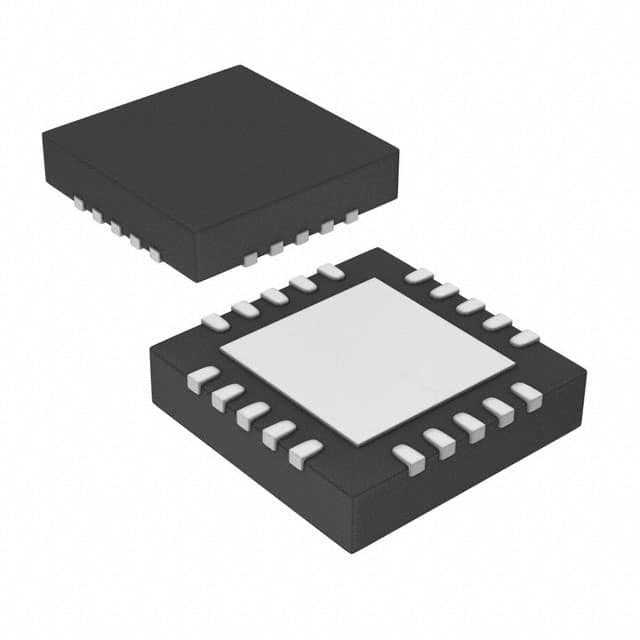PIC16F1619-I/ML
Product Overview
Category
The PIC16F1619-I/ML belongs to the category of microcontrollers.
Use
This microcontroller is commonly used in various electronic applications that require embedded control and processing capabilities.
Characteristics
- High-performance 8-bit RISC architecture
- Flash program memory with self-read/write capability
- Enhanced mid-range core with 49 instructions
- Wide operating voltage range: 1.8V to 5.5V
- Low power consumption
- Multiple communication interfaces (UART, SPI, I2C)
- Analog-to-Digital Converter (ADC) for sensor interfacing
- Timers and PWM modules for precise timing and control
- Integrated EEPROM for non-volatile data storage
Package
The PIC16F1619-I/ML is available in a small form factor package known as QFN-28.
Essence
The essence of this microcontroller lies in its ability to provide a compact and versatile solution for embedded control applications.
Packaging/Quantity
The PIC16F1619-I/ML is typically packaged in reels containing 250 units per reel.
Specifications
- CPU Speed: Up to 32 MHz
- Program Memory Size: 14 KB
- RAM Size: 1 KB
- Number of I/O Pins: 25
- Operating Temperature Range: -40°C to +125°C
- Supply Voltage Range: 1.8V to 5.5V
- Data EEPROM Size: 256 bytes
- ADC Resolution: 10-bit
- Communication Interfaces: UART, SPI, I2C
- Timers: 3 x 8-bit, 1 x 16-bit
- PWM Modules: 2
- Oscillator Options: Internal, External, or Crystal
Detailed Pin Configuration
The PIC16F1619-I/ML microcontroller has a total of 28 pins. The pin configuration is as follows:
- RA0 - Analog Input / Digital I/O
- RA1 - Analog Input / Digital I/O
- RA2 - Analog Input / Digital I/O
- RA3 - Analog Input / Digital I/O
- RA4 - Digital I/O
- RA5 - Digital I/O
- VSS - Ground
- MCLR/VPP - Master Clear / Programming Voltage
- VDD - Power Supply
- RC0 - Digital I/O
- RC1 - Digital I/O
- RC2 - Digital I/O
- RC3 - Digital I/O
- RC4 - Digital I/O
- RC5 - Digital I/O
- VSS - Ground
- OSC1/CLKIN - Oscillator Input
- OSC2/CLKOUT - Oscillator Output
- RC6 - Digital I/O
- RC7 - Digital I/O
- RB0 - Digital I/O
- RB1 - Digital I/O
- RB2 - Digital I/O
- RB3 - Digital I/O
- RB4 - Digital I/O
- RB5 - Digital I/O
- VSS - Ground
- RB7 - Digital I/O
Functional Features
The PIC16F1619-I/ML microcontroller offers the following functional features:
- High-performance RISC architecture for efficient execution of instructions.
- Flash program memory with self-read/write capability, allowing for easy firmware updates.
- Enhanced mid-range core with a wide range of instructions for versatile programming.
- Multiple communication interfaces (UART, SPI, I2C) for seamless integration with other devices.
- Analog-to-Digital Converter (ADC) for precise measurement and interfacing with sensors.
- Timers and PWM modules for accurate timing and control of external devices.
- Integrated EEPROM for non-volatile data storage, ensuring data retention even during power loss.
Advantages and Disadvantages
Advantages
- Compact size and low power consumption make it suitable for portable and battery-powered applications.
- Wide operating voltage range allows for flexibility in different power supply scenarios.
- Versatile communication interfaces enable easy integration with other devices.
- Rich set of peripherals (ADC, timers, PWM) provide enhanced functionality.
- Flash program memory allows for easy firmware updates and customization.
Disadvantages
- Limited program memory size may restrict the complexity of applications.
- Limited RAM size may impose constraints on data storage and processing capabilities.
- Lack of built-in hardware encryption or security features may require additional measures for secure applications.
Working Principles
The PIC16F1619-I/ML microcontroller operates based on the principles of a RISC architecture. It executes instructions stored in its flash program memory to perform various tasks. The core of the microcontroller is designed to efficiently execute instructions, enabling
Senaraikan 10 soalan dan jawapan biasa yang berkaitan dengan aplikasi PIC16F1619-I/ML dalam penyelesaian teknikal
What is the maximum operating frequency of PIC16F1619-I/ML?
- The maximum operating frequency of PIC16F1619-I/ML is 32 MHz.Can PIC16F1619-I/ML be used for motor control applications?
- Yes, PIC16F1619-I/ML can be used for motor control applications with its integrated peripherals and PWM capabilities.Does PIC16F1619-I/ML support communication protocols like I2C and SPI?
- Yes, PIC16F1619-I/ML supports communication protocols such as I2C and SPI.What are the available memory options for program storage in PIC16F1619-I/ML?
- PIC16F1619-I/ML offers flash program memory options ranging from 3.5 to 14 KB.Can PIC16F1619-I/ML be used in battery-powered applications?
- Yes, PIC16F1619-I/ML is suitable for battery-powered applications due to its low power consumption features.Are there any development tools available for programming PIC16F1619-I/ML?
- Yes, there are various development tools and IDEs available for programming and debugging PIC16F1619-I/ML.What are the analog-to-digital converter (ADC) specifications of PIC16F1619-I/ML?
- PIC16F1619-I/ML features a 10-bit ADC with up to 24 channels for analog input.Can PIC16F1619-I/ML be used in automotive applications?
- Yes, PIC16F1619-I/ML is suitable for automotive applications with its robust design and temperature range.Does PIC16F1619-I/ML have built-in security features?
- Yes, PIC16F1619-I/ML offers various security features to protect the code and data.What are the available package options for PIC16F1619-I/ML?
- PIC16F1619-I/ML is available in various package options including QFN, UQFN, and DIP.


